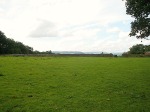OS grid reference SD 7460 3553. About three-quarters of a mile east of Whalley in the Ribble Valley, Lancashire, beside Portfield Lane stands the prehistoric site known as Portfield hillfort or Planes Wood Settlement, a promontory-type fort. Just half a mile to the west is the busy A680 Accrington Road and Spring Woods, with carparks and a number of woodland paths for the visitor to explore at leisure – all far removed from the Iron-Age hillfort-cum-settlement that lies just beyond. The hillfort with it’s man-made defensive ramparts can be found just behind Portfield farm and the splendid 14th century tithe barn, a timber construction that was associated with Whalley Abbey. Close by is Leck beck and down in the valley at Whalley the river Calder winds it’s way southwards beneath Whalley Nab towards Great Harwood. In 1966 a hoard of Bronze-Age artefacts was dug up in the middle of the hillfort.
The fort covers an area of about three-and-a-half acres (roughly 152,460 square feet) and, although it is accepted that it dates from the Iron-Age, there was almost certainly a much earlier settlement or enclosure on this site that was inhabited in the Mesolithic, Neolithic and Bronze-Age periods of prehistory, which would be 4,000 years BC or more. There were two main phases of construction in the case of the Iron-Age fort’s defensive ramparts, as is now known from the archaeological excavations that took place in the late 1950s.
The first phase sometime between 1,000-750 BC? was a stone rampart (with no ditch) about 13 feet across with stone kerbs on their sides at the back of the inside defense, while the second phase involved the levelling of the first rampart to construct bigger but ‘unusually’ low defensive bivallate ramparts, which were stone-revetted and upto 20 feet in width surrounding the enclosure area of the fort – being especially well-defined at the north-west side but, less so at the south-eastern and east sides. Beyond this there was a 20 foot wide berm and a ditch measuring 15-18 feet across. The excavations of 1958 and 1959 revealed a cobbled pavement at the main entrance to the fort, and over this another layer of stones. It was here that a fragment of Romano-British Roman pottery was discovered dating from the 5th century AD. A couple of the back gardens of the houses on Portfield lane have rather intruded onto what’s left of the eastern rampart, although this does not ‘in any way’ spoil the situation of the prehistoric site.
In 1966 while workmen were laying new pipes near the centre of the fort a hoard of Bronze-Age artefacts was uncovered – among the items found were two axes, a tanged knife and blade, a tanged stud, a gauge, part of a hilt, but much more of interest was the discovery of a gold penannular bracelet (possibly of Irish craftsmanship) and a gold tress-ring dating from the mid to late Bronze-Age. Then, in excavations during 1970-71, post holes were found as well as body sherds, flints and pottery sherds from a biconical vessel. There have also recently been a few finds dating back to the Mesolithic and the Neolithic ages, including flints and pottery. Many replicas of these artefacts can be viewed in The Blackburn museum and also The Ribchester Roman museum.
Joan Allen (1977) tells us that: “In September 1966, two Manchester Corporation workmen, digging a ditch in a meadow at Portfield Farm, Whalley, Lancs., located a gold armlet, gold hair-ornament (called a tress ring), a carpenter’s gauge and a number of bronze axe-heads and other tools. Museum experts believed that Bronze Age craftsmen had hoarded them underground between 700 and 800 B.C.”
Sources:-
Allen, Joan, Glittering Prospects—All You Need To Know About ‘Treasure Hunting’, Elm Tree Books Ltd., London, 1977.
Dixon, John & Dixon, Phillip., Journeys Through Brigantia (Vol 9) The Ribble Valley, Aussteiger Publications, Barnoldswick, 1993.
http://www.pastscape.org.uk/hob.aspx?hob_id=44511
http://www.webbaviation.co.uk/gallery/v/lancashire/whalley/PortfieldHillfort-fb34133.jpg.html



